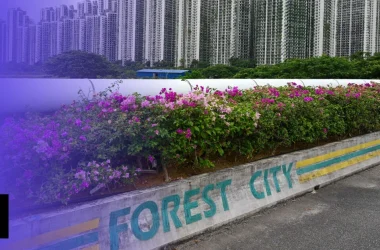India’s newest engineering marvel rises from the depths of the sea to connect bustling cities in a way that revolutionizes the landscape of India’s financial center and most populous city, Mumbai.
This new $2.2 billion megaproject marks an important milestone as the country’s longest sea bridge, built using cutting-edge technology never seen before in India.
The scale of this project is so massive that it required enough steel to build a staggering 17 Eiffel Towers. For India, this bridge isn’t just another engineering project, but a gateway to so many benefits.
We’re going to walk you through every detail of this project, from the deep-rooted motivations that sparked its inception, to the economic advantages it promises will transform the lives of millions.
The Problem with Mumbai
Mumbai, India’s financial capital, is known for its large markets and beautiful, towering buildings. But, underneath the city’s glimmering surface, lies a huge problem; Mumbai is intensively overcrowded.
With a population of 21.6 million people and a size of 603.4 square kilometers, the city’s density is an unbelievable 35,918 people per one square kilometer. As you’d expect, this created massive traffic in the city’s streets and roads, and the old six bridges that linked Mumbai with Navi Mumbai were always fully occupied with vehicles.
And so, in 2015, the Indian government gave the green light to the Mumbai Trans Harbour Link, or MTHL, a new massive bridge megaproject that would help solve Mumbai’s congestion problem. Then, a year later in December of 2016, India’s prime minister, Narendra Modi, laid the foundation stone for the project.
The MTHL
The project was completed exactly 7 years after construction started, and it’s already being touted as one of India’s most important and remarkable infrastructure projects to date, so why is it receiving this much attention?
For starters, it’s the longest sea bridge in India at 22 kilometers, and the 12th longest in the entire world, which is considered a great achievement for the country. Out of those 22 kilometers, 16.5 are over the sea while the other 5.5 are on land.
The part that’s over the sea is composed of a six-lane highway with three on each side, and after the first 10 kilometers, users of the bridge get to enjoy stunning views of the Mumbai Skyline and the Elephanta Caves.
The bridge has enough capacity to handle 70,000 vehicles daily, and it has a lot of advanced features implemented that drivers can make use of. One of these features is India’s first ever open road tolling system, which collects tolls automatically and allows cars to pass through toll booths at speeds of up to 100 kilometers per hour without having to stop.
To help drivers navigate, the bridge will include electronic signs that display messages and information for drivers, instead of traditional signs. But, motorcycles, tractors, and auto rickshaws won’t be able to join the fun, as they aren’t allowed on the bridge. In order to ensure this regulation, cameras were placed every 330 meters on the bridge.
The bridge was designed with vision barriers and noise barriers, with the noise barriers meant to block the noise of passing vehicles in order to protect the movement of flamingos and other migrating birds in the area. On the other hand, the vision barriers are meant to shield the Bhabha Atomic Research Center from the cars passing on the bridge for security reasons.
The MTHL doesn’t just accommodate cars, but ships as well. In fact, there’s a 4 kilometer steel span section in the middle of the bridge that will allow ships to pass underneath the bridge with ease, a feat that was accomplished by building orthotropic decks, a first in India.
Orthotropic decks provide a more efficient alternative to the traditional concrete decks for lifting up bridges, allowing them to have longer spans, since an orthotropic deck can reduce the weight of the entire structure it’s holding by as much as 25%, compared to a concrete deck.
For the MTHL, having 70 of these decks helps the ships passing underneath it enjoy a longer span, without the need for support pillars that could obstruct shipping routes in the area.
Benefits to Mumbai
The bridge offers a lot of benefits for Mumbai’s citizens, with the main one being saving time for commuters. You might find this unbelievable, but this amazing bridge reduces the time you need to travel from Mumbai to Navi Mumbai from 2 hours to 20 or 25 minutes!
Because of this, the bridge is expected to save hundreds of thousands of liters of car fuel and cut back CO2 emissions by over 25,000 million tons.
It’s also well-connected to other transportation hubs in the area, like the under construction Navi Mumbai International Airport and the Mumbai-Pune Expressway, ensuring strong connectivity for citizens in the area, as well as globally.
It is this connectivity that is making us think that the MTHL will completely transform Mumbai’s real estate market, since it would encourage real estate prices to appreciate in value as demand for homes, driven by professionals seeking housing close to prime business hubs in India’s financial capital, surges.
It could also drive up real estate demand in the places it connects, like Panvel, Sewri, and many others that were considered less desirable in the real estate market.
The Construction
The Indian government put a lot of thought into this project, because it faced a lot of challenges that required significant planning and effort to overcome. In fact, its construction was no walk in the park.
Construction started in 2018 and was supposed to be completed in 2021, but it was delayed thanks to the Covid-19 pandemic, which cost the Indian government a long eight months of work days.
Just by looking at the amount of material used for the construction, you can tell that its size proved itself to be a challenge. The bridge was built using 165,000 tons of reinforcement steel, 96,250 tons of structural steel, and 830,000 cubic meters of concrete.
Thanks to its massive size and the fact that it was being built over the sea, only 3% of the project was built on site while the rest of it was assembled elsewhere and then transported to the construction site for installation.
Building the bridge over the sea was the biggest challenge that faced the construction team, as they had to dig 47 meters into the sea to provide the bridge with a strong foundation, while being careful about destroying pipe lines or communication cables in the sea, at the same time.
To overcome this problem, the engineers utilized a construction method called reverse circulation drilling, which is a hydraulic drilling method that digs holes with large diameters in order to speed up construction in marine areas.
Despite the harsh challenges, the construction team didn’t ignore the potential environmental impacts of the project. In fact, they fitted all the construction equipment that was used with silencers to reduce the noise’s impact on the wildlife in the area.
Immediate Returns
Thanks to the hard work of 17,000 workers working 38-hours shifts, 1,500 engineers, and expert consultants from countries with great infrastructure expertise like the U.K. and Japan, the bridge was completed.
Now, its purpose is to give Mumbai’s infrastructure a complete makeover, along with other megaprojects like the upcoming Navi Mumbai International Airport.
But, Narendra Modi was quick to use those megaprojects for politics as well, taking a dig at the previous government during the inauguration event and saying that he was providing India with living proof of development, while the old government delayed projects for years and commissioned them at extremely high costs.
Politics aside, if you think that the main purpose of large-scale megaprojects like this one is to benefit their country, you’d be glad to hear that India is already reaping the benefits of the MTHL, even though it was inaugurated very recently.
In fact, over 30,000 vehicles used the MTHL daily in its first 10 days of being open to the public, which resulted in a revenue of around $740,000 through toll charges alone, according to new data provided by the Mumbai Metropolitan Region Development Authority.
It seems like the MTHL is already a highly successful project, which will bring Mumbai and India as a whole a lot of money. To conclude, we can say that this milestone project definitely adds a lot of value to India’s construction industry and its emerging and rapidly growing economy.
We can definitely see India becoming one of the world’s top economic superpowers thanks to the heavy investments in impressive megaprojects like this one, and we can’t wait to see other Indian projects we talked about completed.
Disclaimer
Please visit and read our disclaimer here.









